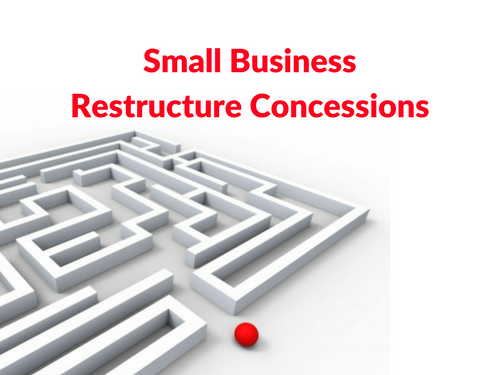Small business restructure roll-over concessions

What happens if you are in the wrong structure? Have you ever had a chat with a colleague or mate and thought “why aren’t I doing that” or “I wish I could change the way my business works”.
The government recently announced changes that were specifically aimed at small business taxpayers. Some of these changes have been discussed in my article “Great news for everyone running a small business”.
But in relation to the questions above - we think that the most significant change, was the introduction of a new form of rollover relief which apples to small business from 1 July 2016.
These rules are designed to enable small businesses to restructure their business operations without creating messy tax problems.
Basically businesses that tick all the following boxes will be able to benefit from the new rules:
- One entity transfers an asset to one or more other entities,
- That transfer is part of a genuine restructure of an ongoing business,
- The entities that are involved are all Small Business Entities (SBEs have a turnover of less than $10million), or are connected with a SBE, or are an affiliate of a SBE,
- The individuals with economic ownership of the asset (the asset could be, for example, a business and its necessary assets like plant & equipment) must not significantly change due to the transfer,
- The asset transferred must be an active asset of the vendor (a business in its entirety can be an active asset),
- Everyone involved must agree to choose the rollover relief,
- Everyone must be a resident of Australia, and
- None of the entities involved are super funds.
So, if the new rules can be applied it will mean that any income tax consequences can be ignored (including CGT). However, the measures do not shield the transaction from stamp duty and GST.
The government has made it clear that these rules cannot be used to assist with the winding up or sale of a business to an unrelated party. They have actually come up with rules that stop this from happening. The rules provide that a business must meet the following for 3 years after the change:
- The original owners of the business are still the owners of the business (but in a different structure),
- The original assets of the business are still used in that business,
- Those assets are not significantly used for private purposes.
There is also now guidance of what will be looked at as “Good restructuring” that will most likely be OK, these include restructures for asset protection, to retain key employees, raise new capital, and to simplify matters.
However, there is also “Bad restructuring” mentioned in the guidance including; to prepare a business for disposal to an unrelated party, for succession planning, and to extract wealth form the business.
If you think that any of the concessions discussed above may assist your business please contact us here at Paris Financial.
Ken Burk, Partner, Paris Financial
Image courtesy of Stuart Miles at FreeDigitalPhotos.net
